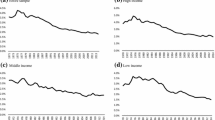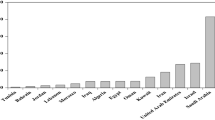Abstract
The present study examines the worldwide effect of military spending on economic growth for the period 1960–2017 utilizing the dynamic common correlated effects estimator that accounts for country heterogeneity and cross-sectional dependence, while it provides not only sample-average coefficients but country-specific coefficients as well. Overall, the worldwide effect of military spending on economic growth over the period 1960–2017 appears to be negative, and this originates from the cold war and early post-cold war era and is especially evident for the North Atlantic Treaty Organization countries. For the post-cold war era, a neutral effect (i.e., no statistical significance) is apparent for the majority of countries. At the country-specific level, there are some economies that consistently benefit or suffer from military spending, while the type of the individual impact for most of the countries varies over different time periods, with no clear pattern.
Similar content being viewed by others
Notes
Popular estimation techniques in the literature are the fixed effects (FEs) and the generalized method of moments (GMM). However, FE does not perform well when heteroskedasticity is present, and the GMM partially accounts for it and is sensitive to outliers. Furthermore, these approaches focus on the average impact, while the DCCEE gives additional information for country-specific impact.
Tables 1 and 2 are also estimated using FE and GMM. The FE method found qualitatively similar impact for all variables, though the magnitude was weaker, and the GMM methodology found more frequently lack of statistical significance for all variables, and when it found statistical significance, the magnitudes were similar to those of the FE. It should be noted that their essential econometric differences (individual vs average effect) with the DCCEE method make any direct comparisons not meaningful.
References
Aizenman J, Glick R (2006) Military expenditure, threats, and growth. J Int Trade Econ Dev 15(2):129–155. https://doi.org/10.1080/09638190600689095
Alexander W (1990) The impact of defense spending on economic growth. Def Econ 2(1):39–55. https://doi.org/10.1080/10430719008404677
Alptekin A, Levine P (2012) Military expenditure and economic growth: a meta-analysis. Eur J Polit Econ 28(4):636–650. https://doi.org/10.1016/J.EJPOLECO.2012.07.002
Baltagi BH, Pesaran MH (2007) Heterogeneity and cross section dependence in panel data models: theory and applications introduction. J Appl Econom 22(2):229–232. https://doi.org/10.1002/jae.955
Banerjee A, Marcellino M, Osbat C (2005) Testing for PPP: should we use panel methods? Empir Econ 30(1):77–91. https://doi.org/10.1007/s00181-004-0222-8
Barro R (2003) Determinants of economic growth in a panel of countries. Ann Econ Finance 4:231–274
Benoit E (1973) Growth and defense in developing countries. Econ Dev Cult Change 26:271–280. https://doi.org/10.2307/1153245
Benoit E (1978) Growth and defense in developing countries. Econ Dev Cult Change 26(2):271–280. https://doi.org/10.1086/451015
Cappelen Å, Gleditsch NP, Bjerkholt O (1984) Military spending and economic growth in the OECD countries. J Peace Res 21(4):361–373. https://doi.org/10.2307/423749
Cavalcanti TVdeV, Mohaddes K, Raissi M (2011) Growth, development and natural resources: new evidence using a heterogeneous panel analysis. Q Rev Econ Finance 51(4):305–318. https://doi.org/10.1016/J.QREF.2011.07.007
Cevik S, Ricco J (2018) No buck for the bang: revisiting the military-growth nexus. Empirica 45(4):639–653. https://doi.org/10.1007/s10663-017-9380-8
Chang H-C, Huang B-N, Yang CW (2011) Military expenditure and economic growth across different groups: a dynamic panel Granger-causality approach. Econ Model 28(6):2416–2423. https://doi.org/10.1016/J.ECONMOD.2011.06.001
Chen PF, Lee CC, Chiu Y Bin (2014) The nexus between defense expenditure and economic growth: new global evidence. Econ Model 36:474–483. https://doi.org/10.1016/j.econmod.2013.10.019
Chudik A, Pesaran MH (2015) Common correlated effects estimation of heterogeneous dynamic panel data models with weakly exogenous regressors. J Econom 188(2):393–420. https://doi.org/10.1016/J.JECONOM.2015.03.007
Churchill AS, Yew SL (2018) The effect of military expenditure on growth: an empirical synthesis. Empir Econ 55(3):1357–1387. https://doi.org/10.1007/s00181-017-1300-z
Cuaresma JC, Reitschuler G (2004) A non-linear defence-growth nexus? evidence from the US economy. Defence Peace Econ 15(1):71–82. https://doi.org/10.1080/1024269042000164504
d’Agostino G, Dunne JP, Pieroni L (2016) government spending, corruption and economic growth. World Dev 84:190–205. https://doi.org/10.1016/j.worlddev.2016.03.011
d’Agostino G, Dunne JP, Pieroni L (2018) Military expenditure, endogeneity and economic growth. Def Peace Econ 30(5):509–524. https://doi.org/10.1080/10242694.2017.1422314
Deger S (1986) Economic development and defense expenditure. Econ Dev Cult Change 35:179–196. https://doi.org/10.2307/1154149
Desli E, Gkoulgkoutsika A, Katrakilidis C (2017) Investigating the dynamic interaction between military spending and economic growth. Rev Dev Econ 21(3):511–526. https://doi.org/10.1111/rode.12268
Ditzen J (2018) Estimating dynamic common-correlated effects in Stata. Stata J Promot Commun Stat Stata 18(3):585–617. https://doi.org/10.1177/1536867X1801800306
Dritsakis N (2004) Defense spending and economic growth: an empirical investigation for Greece and Turkey. J Policy Model 26(2):249–264. https://doi.org/10.1016/j.jpolmod.2004.03.011
Dunne JP, Mohammed NAL (1995) Military spending in Sub-Saharan Africa: some evidence for 1967–85. J Peace Res 32(3):331–343. https://doi.org/10.1177/0022343395032003006
Dunne JP, Nikolaidou E (2012) Defence spending and economic growth in the EU15. Def Peace Econo 23(6):537–548. https://doi.org/10.1080/10242694.2012.663575
Dunne P, Tian N (2013) Military expenditure and economic growth: a survey. Econ Peace Secur J 8(1):5–11. https://doi.org/10.15355/epsj.8.1.5
Dunne JP, Uye M (2010) Military spending and development. In: Tan A (ed) The global arms trade: a handbook. Routledge, London, pp 293–305
Dunne P, Nikolaidou E, Vougas D (2001) Defence spending and economic growth: a causal analysis for Greece and Turkey. Def Peace Econ 12(1):5–26. https://doi.org/10.1080/10430710108404974
Dunne JP, Smith RP, Willenbockel D (2005) Models of military expenditure and growth: a critical review. Def Peace Econ 16(6):449–461. https://doi.org/10.1080/10242690500167791
Faini R, Annez P, Taylor L (1984) Defense spending, economic structure, and growth: evidence among countries and over time. Econ Dev Cult Change 32:487–498. https://doi.org/10.2307/1153333
Frederiksen PC, Looney RE (1983) Defense expenditures and economic growth in development countries: some further empirical evidence. Armed Forces Soc 9(4):633–645
Frederiksen PC, Looney RE (1995) A note on defense budgets and economic growth: developing countries in the 1980s. J Int Comp Econ 4:115–120
Hou N, Chen B (2013) Military expenditure and economic growth in developing countries: evidence from system GMM estimates. Def Peace Econ 24(3):183–193. https://doi.org/10.1080/10242694.2012.710813
Kalaitzidakis P, Tzouvelekas V (2011) Military spending and the growth-maximizing allocation of public capital: a cross-country empirical analysis. Econ Inq 49(4):1029–1041. https://doi.org/10.1111/j.1465-7295.2009.00242.x
Keller K, Poutvaara P, Wagener A (2009) Military draft and economic growth in OECD countries. Def Peace Econ 20(5):373–393. https://doi.org/10.1080/10242690802332994
Khalid MA, Noor ZM (2018) Military expenditure and economic growth in developing countries: evidence from system GMM estimates. J Emerg Trends Econ Manag Sci 9(2):90–98
Kinsella D (1990) Defence spending and economic performance in the United States: a causal analysis. Def Econ 1(4):295–309. https://doi.org/10.1080/10430719008404669
Kollias C, Paleologou SM (2013) Guns, highways and economic growth in the United States. Econ Model 30:449–455. https://doi.org/10.1016/j.econmod.2012.09.048
Landau D (1996) Is one of the “peace dividends” negative? Military expenditure and economic growth in the wealthy OECD countries. Q Rev Econ Finance 36(2):183–195. https://doi.org/10.1016/S1062-9769(96)90038-1
Lim D (1983) Another look at growth and defense in less developed countries. Econ Dev Cult Change 31(2):377–384. https://doi.org/10.1086/451326
Manamperi N (2016) Does military expenditure hinder economic growth? Evidence from Greece and Turkey. J Policy Model 38(6):1171–1193. https://doi.org/10.1016/J.JPOLMOD.2016.04.003
Mintz A, Huang C (1990) Defense expenditures, economic growth, and the “peace dividend. Am Polit Sci Rev 84(4):1283–1293. https://doi.org/10.2307/1963264
Ortiz C, Alvarado R, Salinas A (2019) The effect of military spending on output: new evidence at the global and country group levels using panel data cointegration techniques. Econ Anal Policy 62:402–414. https://doi.org/10.1016/j.eap.2018.10.004
Pesaran MH (2004) General diagnostic tests for cross section dependence in panels. Cambridge Working Papers in Economics, University of Cambridge, No. 435(Working Paper Series No. 1229). Retrieved from ftp.iza.org/dp1240.pdf
Sala-i-Martin X, Doppelhofer G, Miller RI (2004) Determinants of long-term growth: a Bayesian averaging of classical estimates (BACE) approach. Am Econ Rev 94(4):813–835
SIPRI databases (2019). Retrieved February 11, 2019, from https://www.sipri.org/databases
Smith RP (1980) Military expenditure and investment in OECD countries, 1954–1973. J Comp Econ 4(1):19–32. https://doi.org/10.1016/0147-5967(80)90050-5
Strauss J, Yigit T (2003) Shortfalls of panel unit root testing. Econ Lett 81(3):309–313. https://doi.org/10.1016/S0165-1765(03)00210-6
Stroup MD, Heckelman JC (2001) Size of the military sector and economic growth: a panel data analysis of Africa and Latin America. J Appl Econ 4(2):329–360. https://doi.org/10.1080/15140326.2001.12040568
Ward MD, Davis DR (1992) Sizing up the peace dividend: economic growth and military spending in the United States, 1948–1996. Am Polit Sci Rev 86(03):748–755. https://doi.org/10.2307/1964136
World Bank Open Data (2019) Retrieved January 8, 2019, from https://data.worldbank.org/
Yesilyurt F, Yesilyurt ME (2019) Meta-analysis, military expenditures and growth. J Peace Res 56(3):352–363. https://doi.org/10.1177/0022343318808841
Acknowledgements
The authors would like to thank the editor and the anonymous reviewers for their valuable comments. The usual disclaimer applies.
Author information
Authors and Affiliations
Corresponding author
Additional information
Publisher's Note
Springer Nature remains neutral with regard to jurisdictional claims in published maps and institutional affiliations.
Rights and permissions
About this article
Cite this article
Desli, E., Gkoulgkoutsika, A. Military spending and economic growth: a panel data investigation. Econ Change Restruct 54, 781–806 (2021). https://doi.org/10.1007/s10644-020-09267-8
Received:
Accepted:
Published:
Issue Date:
DOI: https://doi.org/10.1007/s10644-020-09267-8




